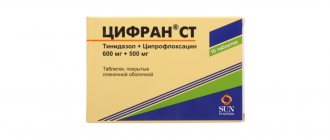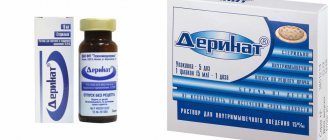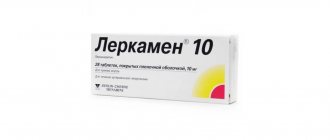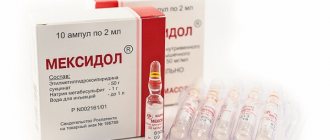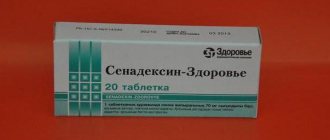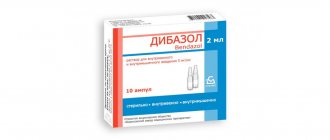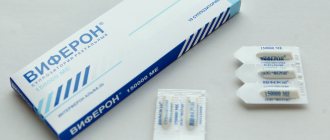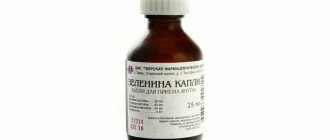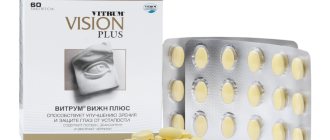Compound
| Each tablet contains the active substance: | |
| Erythromycin (in terms of active substance) 250 mg | |
| Tween-80 (polysorbate) | 5.8 mg |
| Calcium stearate | 4.8 mg |
| Polyvinylpyrrolidone (povidone) | 29.6 mg |
| Croscarmellose sodium | 9.0 mg |
| Potato starch | To obtain an uncoated tablet weighing 450.0 mg |
| Shell excipients: | |
| Titanium dioxide | 0.5 mg |
| 1,2-propylene glycol | 2.3 mg |
| Collicut MAE 100R | 15.1 mg |
| Talc | 4.1 mg |
Description:
Round biconvex tablets, film-coated, white or white with a grayish tint; On a cross section, the core is white or almost white.
Pharmacotherapeutic group: antibiotic - macrolide.
ATX code:
J01FA01
Pharmachologic effect:
Pharmacodynamics
A bacteriostatic antibiotic from the macrolide group, reversibly binds to the 50S subunit of bacterial ribosomes, blocks protein synthesis, prevents the growth and reproduction of bacteria (does not affect the synthesis of nucleic acids). In high doses it can have a bactericidal effect. The spectrum of activity includes gram-positive (Staphylococcus spp., producing and non-producing penicillinase, including Staphylococcus aureus; Streptococcus spp. (including Streptococcus pneumoniae, Streptococcus pyogenes), alpha-hemolytic streptococcus (Viridans group), Bacillus anthracis, Corynebacterium diphtheriae, Corynebacterium minutissimum) and gram-negative microorganisms (Neisseria gonorrhoeae, Haemophilus influenzae, Bordetella pertussis, Brucella spp., Legionella spp., including Legionella pneumophila) and other microorganisms: Mycoplasma spp. (including Mycoplasma pneumoniae), Chlamydia spp. (including Chlamydia trachomatis), Treponema spp., Rickettsia spp., protozoa: Entamoeba histolytica, Listeria monocytogenes.
Gram-negatives are resistant to erythromycin: Escherichia coli, Pseudomonas aeruginosa, as well as Shigella spp., Salmonella spp. and others. The sensitive group includes microorganisms whose growth is delayed at an antibiotic concentration of less than 0.5 mg/l, moderately sensitive - 1-6 mg/l, moderately resistant and resistant - 6-8 mg/l.
Pharmacokinetics
Absorption is high. Eating does not affect the absorption of erythromycin enteric-coated tablets. The maximum concentration (Cmax) is reached after 2-4 hours. Communication with plasma proteins is 70-90%.
Bioavailability - 30-65%. It is distributed unevenly in the body. It accumulates in large quantities in the liver, spleen, and kidneys. In bile and urine, the concentration is tens of times higher than the concentration in plasma. Penetrates well into the tissues of the lungs, lymph nodes, middle ear, prostate secretions, sperm, pleural cavity, ascitic and synovial fluid. In the milk of lactating women, the concentration of erythromycin is 50% of the serum concentration. Penetrates poorly through the blood-brain barrier. During inflammatory processes in the meninges, their permeability to erythromycin increases slightly. Penetrates through the placental barrier.
Metabolizes in the liver (more than 90%), partially with the formation of inactive metabolites. The half-life (T1/2) is 1.4-2 hours, with anuria - 4-6 hours. Excretion with bile - 20-30% unchanged, by the kidneys (unchanged) - 2-5%.
Erythromycin tablets 0.1 No. 20
General characteristics: international and chemical names: erythromycin; (3R,4S,5S,6R,7R,9R,11R,12R,13S,14R)-4-[(2,6-dideoxy-3-C-methyl-3-O-methyl-aL-ribo-hexopyranosyl) -oxy]-14-ethyl-7,12,13-trihydroxy-3,5,7,9,11,13-hexamethyl-6-[[3,4,6-trideoxy-3-dimethylamino-bD-xyl- hexopyranosyl]-oxy]-oxacyclotetradecane-2,10-dione (erythromycin A); basic physical and chemical properties: round tablets, white, almost white or white with a yellowish tint, with a biconvex surface. Subtle inclusions are allowed; composition: 1 tablet contains erythromycin in terms of 1000 mcg/mg (IU/mg) and anhydrous substance - 100 mg; excipients: potato starch, calcium stearate, aerosil.
Release form. Pills.
Pharmacotherapeutic group. Antibacterial agents for systemic use. Macrolides. Erythromycin. ATC code J01FA01.
Pharmacological properties. Pharmacodynamics . Erythromycin is a macrolide antibiotic with bacteriostatic action. In high concentrations and against highly sensitive microorganisms it can have a bactericidal effect. Penetrates the bacterial cell membrane and reversibly binds to the 50S subunit of bacterial ribosomes; inhibits the translocation of peptides from the acceptor site of the ribosome to the donor site, preventing further protein synthesis. Active against gram-positive bacteria: Streptococcus pyogenes, Streptococcus viridans, Streptococcus pneumoniae, Staphylococcus aureus, Corynebacterium diphtheriae, Corynebacterium minutissimum, Listeria monocytogenes; against gram-negative bacteria: Bordetella pertussis, Legionella pneumophila, some strains of Haemophilus influenzae, Mycoplasma pneumoniae, as well as against Entaemoeba hystolitica, Chlamydia trachomatis, Treponema pallidum. Gram-negative bacilli are resistant to the action of erythromycin: Escherichia coli, Pseudomonas aeruginosa, as well as Shigella and Salmonella. Pharmacokinetics . Absorbed in the digestive tract, the rate of absorption depends on the individual characteristics of the body. Bioavailability is 30-65%. The maximum concentration in the blood is observed 2 hours after administration. Distributed in most tissues and body fluids, penetrates the placental barrier and into breast milk. Plasma protein binding is 70–90%. Metabolized in the liver, partially with the formation of inactive metabolites. A significant part of erythromycin is excreted from the body in bile and only 2-5% unchanged in urine. The half-life is 1.4-2 hours with normal renal function.
Indications for use. Infectious and inflammatory diseases caused by microorganisms sensitive to the drug, including pneumonia, pneumopleuritis, bronchiectasis in the acute stage, septic conditions, erysipelas, mastitis, osteomyelitis, peritonitis, purulent otitis and other purulent-inflammatory processes; diphtheria, whooping cough, trachoma, brucellosis, scarlet fever; gonorrhea, syphilis in patients with hypersensitivity to penicillin drugs; other infections caused by microorganisms resistant to penicillin, tetracyclines, chloramphenicol, streptomycin.
Method of administration and dose. They are set individually, depending on the location and severity of the infection and the sensitivity of the pathogen. Prescribed orally 1 1.5 hours before or 2 3 hours after meals. Adults: 200-500 mg 4 times a day; highest single dose 500 mg, daily dose 2 g. Children from 3 to 6 years old 500-700 mg per day; from 6 to 8 years 700 mg per day; from 8 to 14 years up to 1 g per day, dividing the daily dose into 4 doses; over 14 years of age at the adult dose. The course of treatment is 5-14 days; after the symptoms of the disease disappear, they are used for another 2 days.
Side effect. From the digestive system, nausea, vomiting, epigastric pain, cholestatic jaundice are possible; from the senses: hearing loss and/or tinnitus, which disappears after discontinuation of the drug; allergic reactions: skin rash, urticaria, anaphylactic shock; effects caused by chemotherapy: oral candidiasis, vaginal candidiasis.
Contraindications. Hypersensitivity to erythromycin and macrolides, severe liver dysfunction, children under 3 years of age.
Overdose. Symptoms: nausea, vomiting, diarrhea and discomfort in the stomach; impaired liver function, up to acute liver failure; hearing loss, tinnitus, dizziness (especially in patients with renal or liver failure). Treatment: the use of activated carbon, careful monitoring of respiratory status (if necessary, mechanical ventilation), acid-base balance and electrolyte metabolism. Gastric lavage is effective when taking a dose that is 5 times the average therapeutic dose. Hemodialysis, peritoneal dialysis and forced diuresis are ineffective.
Features of application. Prescribe with caution for impaired liver and kidney function. When carrying out long-term therapy with Erythromycin or when taking large doses of the drug, it is necessary to monitor liver function indicators. Symptoms of cholestatic jaundice may develop after 7 to 14 days of continuous therapy with Erythromycin. Patients with a history of partial hearing loss may be at increased risk of further hearing loss, especially if they are elderly, have impaired renal or hepatic function, and are receiving large doses of erythromycin. With long-term use of Erythromycin, microorganisms may develop resistance to the drug and to other macrolide antibiotics. There are no references to the fact that Erythromycin can adversely affect psychomotor reactions in drivers and people working with equipment. Drugs that increase gastric acidity and acidic drinks inactivate erythromycin. Erythromycin should not be taken with milk or dairy products. When prescribing Erythromycin during pregnancy, it is necessary to evaluate the possible benefits to the mother and the potential risk to the fetus. If it is necessary to prescribe during lactation, the issue of stopping breastfeeding must be resolved.
Interaction with other drugs. The simultaneous use of Erythromycin and lincomycin or chloramphenicol weakens their effect. Erythromycin increases the concentration of theophylline, aminophylline, carbamazepine, and caffeine in the blood plasma, thereby increasing the risk of their toxic effects. The simultaneous use of Erythromycin and digoxin causes an increase in the level of digoxin in the blood plasma. Erythromycin inhibits the metabolism of ergotamine, increasing ergotamine-associated vasospasm. With the simultaneous use of Erythromycin and other drugs that have hepatotoxic or ototoxic effects, the risk of hepatotoxic or ototoxic effects increases. With the simultaneous use of lovastatin and Erythromycin, the risk of acute skeletal muscle necrosis, which can usually develop after the end of treatment with Erythromycin, may increase. With the simultaneous use of midazolam or triazolam and Erythromycin, the clearance of these drugs may decrease, as a result of which the pharmacological effect of midazolam and triazolam is enhanced. An increase in the effect of anticoagulants has been described when used simultaneously with Erythromycin. This effect is more pronounced in older people. The drug increases the concentration of cyclosporine in the blood plasma and may increase the risk of nephrotoxicity. The effect of Erythromycin is enhanced in combination with sulfonamides and tetracyclines.
Conditions and shelf life. Store in a dry place, protected from light and out of reach of children, at a temperature not exceeding 25 C.
Best before date. 3 years.
Vacation conditions. On prescription.
Package. 20 tablets in a blister pack.
Indications for use
Infectious and inflammatory diseases caused by sensitive microflora: diphtheria (including bacterial carriage), whooping cough (including prevention), trachoma, brucellosis, Legionnaires' disease, erythrasma, listeriosis, scarlet fever, amoebic dysentery, gonorrhea; genitourinary infections in pregnant women caused by Chlamydia trachomatis; uncomplicated chlamydia in adults (with localization in the lower genitourinary tract and rectum), with intolerance or ineffectiveness of tetracyclines, etc.; infections of the ENT organs (tonsillitis, otitis media, sinusitis); biliary tract infections (cholecystitis); infections of the upper and lower respiratory tract (tracheitis, bronchitis, pneumonia); infections of the skin and soft tissues (adolescent acne, infected wounds, bedsores, stage II burns, trophic ulcers), infections of the conjunctiva.
Infections caused by streptococci (tonsillitis, pharyngitis).
Prevention of infectious complications during medical and diagnostic procedures (including dental interventions, endoscopy, in patients with heart defects).
Treatment of infectious and inflammatory diseases caused by pathogens (in particular Staphylococcus spp.) resistant to penicillin, tetracycline, chloramphenicol, streptomycin
Directions for use and dosage:
Inside.
A single dose for adults and adolescents over 14 years of age is 250-500 mg, daily - 1-2 g. The interval between administration is 6 hours. For severe infections, the daily dose can be increased to 4 g.
For the treatment of diphtheria carriage - 250 mg 2 times a day.
For amoebic dysentery in adults - 250 mg 4 times a day, course duration - 10-14 days.
For legionellosis - 500-1000 mg 4 times a day for 14 days.
For gonorrhea - 500 mg every 6 hours for 3 days, then 250 mg every 6 hours for 7 days.
For tonsillitis, pharyngitis, adults - 20-50 mg/kg/day, children - 20-30 mg/kg/day, course duration - at least 10 days.
For the prevention of septic endocarditis in patients with heart defects - 1 g for adults 1 hour before a treatment or diagnostic procedure, then 0.5 g for adults again after 6 hours.
For whooping cough - 40-50 mg/kg/day for 5-14 days.
For genitourinary infections during pregnancy - 500 mg 4 times a day for 7 days or (if tolerated) - 250 mg 4 times a day for 14 days.
In adults, with uncomplicated chlamydia and intolerance to tetracyclines - 500 mg 4 times a day for at least 7 days.
Side effect
From the digestive system: nausea, vomiting, gastralgia, abdominal pain, tenesmus, diarrhea, dysbacteriosis, rarely - oral candidiasis, pseudomembranous enterocolitis, liver dysfunction, cholestatic jaundice, increased activity of “liver” transaminases, pancreatitis.
On the part of the hearing organs: ototoxicity - hearing loss and/or tinnitus (when used in high doses - more than 4 g / day, usually reversible).
From the cardiovascular system: prolongation of the QT interval on the ECG, atrial fibrillation and/or flutter (in patients with a prolonged QT interval on the ECG).
Allergic reactions: urticaria, other forms of skin rash, eosinophilia, rarely - anaphylactic shock.
Interactions and side effects
Erythromycin is metabolized by cytochrome P450 3A4, 3A5, 3A7. Therefore, the biotransformation of substances that are metabolized by these same enzymes may be slowed down. These substances include, for example, cyclosporine, diazepam, lidocaine, warfarin. When used together with erythromycin, there is a possibility of their excessive accumulation in the body.
Erythromycin is well tolerated by the human body . The most common side effects are mild gastrointestinal disorders. Erythromycin is a powerful prokinetic agent that accelerates gastric emptying. Very rarely, allergic reactions, tinnitus, and temporary hearing loss may occur.
Interaction with other drugs
Reduces the bactericidal effect of beta-lactam antibiotics (penicillins, cephalosporins, carbapenems).
Increases the nephrotoxicity of cyclosporine (especially in patients with concomitant renal failure).
Reduces the clearance of triazolam and midazolam, and therefore may enhance the pharmacological effects of benzodiazepines.
Slows down the elimination (increases the effect) of methylprednisolone, felodipine and coumarin anticoagulants.
Increases the bioavailability of digoxin.
Reduces the effectiveness of hormonal contraception.
Drugs that block tubular secretion prolong the half-life of erythromycin.
When taken simultaneously with drugs that are metabolized in the liver (theophylline, carbamazepine, valproic acid, hexobarbital, phenytoin, alfentanil, disopyramide, lovastatin, bromocriptine), the concentration of these drugs in plasma may increase (it is an inhibitor of microsomal liver enzymes).
When taken simultaneously with terfenadine or astemizole - the possibility of developing arrhythmia, with dihydroergotamine or non-hydrogenated ergot alkaloids - vasoconstriction to spasm, dysesthesia.
Incompatible with chloramphenicol (antagonism).
When co-administered with lovastatin, rhabdomyolysis increases.
Erythromycin tablets po enteric soluble 500 mg No. 5x2
Name
Erythromycin tablet, coated, vol. 500 mg in container pack No. 5x2
Description
Tablets, film-coated, enteric-coated, white or almost white, oval, biconvex; A cross section shows one white layer.
Main active ingredient
Erythromycin
Release form
Tablets, film-coated, enteric-coated, white or almost white, oval, biconvex; A cross section shows one white layer.
Dosage
500 mg №5x2
special instructions
Use with caution in case of impaired liver and/or kidney function. Drugs that increase gastric acidity and acidic drinks inactivate erythromycin. Erythromycin should not be taken with milk or dairy products.
pharmachologic effect
Antibiotic of the macrolide group. Has a bacteriostatic effect. However, in high doses it has a bactericidal effect against sensitive microorganisms. Erythromycin reversibly binds to bacterial ribosomes, thereby inhibiting protein synthesis. Active against gram-positive bacteria: Staphylococcus spp. (strains producing and not producing penicillinase), Streptococcus spp. (including Streptococcus pneumoniae); gram-negative bacteria: Neisseria gonorrhoeae, Haemophilus influenzae, Bordetella pertussis, Brucella spp., Legionella spp., Bacillus anthracis, Corynebacterium diphtheriae; anaerobic bacteria: Clostridium spp. Erythromycin is also active against Mycoplasma spp., Chlamydia spp., Spirochaetaceae, Rickettsia spp. Gram-negative bacilli are resistant to erythromycin, incl. Escherichia coli, Pseudomonas aeruginosa, Shigella spp., Salmonella spp.
Pharmacokinetics
Bioavailability is 30-65%. Distributed in most tissues and body fluids. Plasma protein binding is 70-90%. Metabolized in the liver, partially with the formation of inactive metabolites. T1/2 - 1.4-2 hours. Excreted in bile and urine.
Indications for use
Infectious and inflammatory diseases caused by microorganisms sensitive to erythromycin, incl. diphtheria, whooping cough, trachoma, brucellosis, Legionnaires' disease, tonsillitis, scarlet fever, otitis media, sinusitis, cholecystitis, pneumonia, gonorrhea, syphilis. Treatment of infectious and inflammatory diseases caused by pathogens (in particular, staphylococci) resistant to penicillin, tetracyclines, chloramphenicol, streptomycin. For external use: juvenile acne. For local use: infectious and inflammatory eye diseases.
Directions for use and doses
They are set individually depending on the location and severity of the infection and the sensitivity of the pathogen. In adults, a daily dose of 1-4 g is used. Children under 3 months of age - 20-40 mg/kg/day; at the age of 4 months to 18 years - 30-50 mg/kg/day. Frequency of application: 4 times/day. The course of treatment is 5-14 days, after the symptoms disappear, treatment is continued for another 2 days. Take 1 hour before meals or 2-3 hours after meals. Apply the solution for external use to the affected areas of the skin. The ointment is applied to the affected area, and in case of eye diseases, it is placed behind the lower eyelid. The dose, frequency and duration of use are determined individually.
Use during pregnancy and lactation
Erythromycin crosses the placental barrier and is excreted in breast milk. When using erythromycin during pregnancy, the expected benefit to the mother and the potential risk to the fetus should be assessed. If it is necessary to use it during lactation, the issue of stopping breastfeeding should be decided.
Precautionary measures
Use with caution in case of impaired liver and/or kidney function.
Interaction with other drugs
With the simultaneous use of erythromycin with theophylline, aminophylline, caffeine, an increase in their concentration in the blood plasma is observed and thereby increases the risk of developing toxic effects. Erythromycin increases plasma concentrations of cyclosporine and may increase the risk of nephrotoxicity. Drugs that block tubular secretion prolong T1/2 of erythromycin. Incompatible with lincomycin, clindamycin and chloramphenicol (antagonism). Erythromycin reduces the bactericidal effect of beta-lactam antibiotics (penicillins, cephalosporins, carbapenems). When used simultaneously, erythromycin increases theophylline content. When taken simultaneously with drugs that are metabolized in the liver (carbamazepine, valproic acid, hexobarbital, phenytoin, alfentanil, disopyramide, lovastatin, bromocriptine), the concentration of these drugs in plasma may increase (it is an inhibitor of microsomal liver enzymes). IV administration of erythromycin enhances the effect of ethanol (accelerating gastric emptying and reducing the duration of action of alcohol dehydrogenase in the gastric mucosa). Erythromycin reduces the clearance of triazolam and midazolam and may therefore enhance the pharmacological effects of benzodiazepines. When taken simultaneously with terfenadine or astemizole, arrhythmia may develop (ventricular fibrillation and flutter, ventricular tachycardia, even death); with dihydroergotamine or non-hydrogenated ergot alkaloids, vasoconstriction to spasm and dysesthesia is possible. When used simultaneously, it slows down the elimination (increases the effect) of methylprednisolone, felodipine and coumarin anticoagulants. When co-administered with lovastatin, rhabdomyolysis increases. Erythromycin increases the bioavailability of digoxin. Erythromycin reduces the effectiveness of hormonal contraception.
Contraindications
History of jaundice, severe liver dysfunction, hypersensitivity to macrolides.
Compound
In 1 tab. erythromycin 500 mg Excipients: potato starch, polyvinylpyrrolidone (povidone), Kollidon CL-M (crospovidone), polysorbate 80 (Tween 80), calcium stearate, talc. Shell composition: cellulose acetylphthalyl, medical castor oil, titanium dioxide.
Side effect
From the digestive system: nausea, vomiting, epigastric pain, cholestatic jaundice, tenesmus, diarrhea, dysbacteriosis; rarely - pseudomembranous enterocolitis, impaired liver function, increased activity of liver transaminases, pancreatitis. Allergic reactions: skin rash, urticaria, eosinophilia; rarely - anaphylactic shock. Effects caused by chemotherapy: oral candidiasis, vaginal candidiasis. From the senses: reversible ototoxicity - hearing loss and/or tinnitus (when using high doses - more than 4 g / day). From the cardiovascular system: rarely - tachycardia, prolongation of the QT interval on the ECG, atrial fibrillation and/or flutter (in patients with a prolonged QT interval on the ECG). Local reactions: phlebitis at the site of intravenous administration.
Storage conditions
In a place protected from moisture, at a temperature not exceeding 25 °C.
special instructions
Due to the possibility of passage into breast milk, breastfeeding should be discontinued when erythromycin is prescribed.
During long-term therapy, it is necessary to monitor laboratory parameters of liver function.
Symptoms of cholestatic jaundice may develop several days after the start of therapy, but the risk of development increases after 7-14 days of continuous therapy.
The likelihood of developing an ototoxic effect is higher in patients with renal and liver failure, as well as in elderly patients.
Some resistant strains of Haemophilus influenzae are sensitive to simultaneous administration of erythromycin and sulfonamides.
May interfere with the determination of catecholamines in urine and the activity of “liver” transaminases in the blood (colorimetric determination using definylhydrazine).
Instructions for use ERYTHROMYCIN
Hepatotoxicity
Possible dysfunction of the liver with an increase in the level of hepatic aminotransferases and the development of hepatocellular and (or) cholestatic hepatitis with or without jaundice.
QT prolongation
Taking erythromycin may cause QT prolongation and rare cases of arrhythmia. Cases of ventricular arrhythmias such as torsades de pointes have been described in patients receiving erythromycin. The use of erythromycin should be avoided when the QT interval increases, in patients with a high risk of developing arrhythmia (with proarrhythmic risk factors:
- uncorrectable hypokalemia or hypomagnesemia, clinically significant bradycardia), as well as in patients receiving class IA (quinidine, procainamide) or class III antiarrhythmic drugs (dofetilide, amiodarone, sotalol). Elderly patients are more susceptible to QT prolongation.
Syphilis during pregnancy
Taking erythromycin during pregnancy does not produce adequate concentrations to prevent congenital syphilis. Children born to women who received oral erythromycin during pregnancy to prevent early syphilis should receive appropriate treatment with penicillin.
Diarrhea associated with Clostridium difficile
Diarrhea is associated with the use of almost all antibacterial drugs, including erythromycin, and can range in severity from mild diarrhea to fatal colitis. Treatment with antibacterial agents alters the normal flora of the colon, leading to the overgrowth of Clostridium difficile, which produces toxins A and B, which contribute to the development of diarrhea. Overproduction of toxins by Clostridium difficile strains can lead to high morbidity and mortality, as these infections may be refractory to antibiotic therapy and colectomy may be required. The possibility of developing Clostridium difficile-associated diarrhea should be considered in all patients experiencing diarrhea after antibiotic use. A careful history of patients with diarrhea within two months after the administration of antibacterial drugs is necessary. If Clostridium difficile is suspected or confirmed to be the cause of diarrhea, antibacterial therapy not directed against Clostridium difficile should be discontinued. Treatment of diarrhea associated with Clostridium difficile should include correction of water and electrolyte balance, provision of parenteral nutrition, antibiotic therapy against Clostridium difficile, and in some cases the possibility of surgical treatment may be considered.
Due to the presence of lactose in the drug, it is not recommended for patients with congenital galactose intolerance, Lapp lactase deficiency, or glucose-galactose malabsorption.
It is not recommended to use hepatotoxic drugs simultaneously with erythromycin.
You should not drink alcohol during treatment with erythromycin.
Erythromycin and its derivatives, when taking hormonal contraceptives, can reduce their effect. It is recommended to additionally use non-hormonal methods of contraception.
Erythromycin may increase the symptoms of myasthenia gravis.
Use with caution in children under 6 years of age who may have difficulty swallowing.
Impact on the ability to drive vehicles and maintain mechanical devices
There is no data on the effect of the drug on the ability to drive vehicles and operate mechanical devices.
